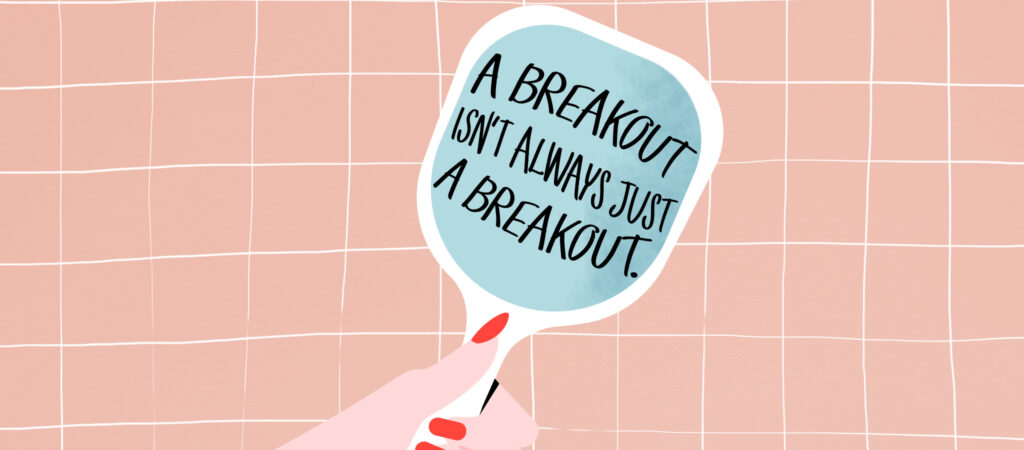Acne or Rosacea: How to Tell The Difference

Medically reviewed by Dr. Nancy Shannon, MD, PhD on June 21, 2021
Though acne and rosacea can appear similar — the two are fully distinct skin conditions that have different treatment approaches. Telling the two apart can be difficult, but it’s absolutely necessary for ensuring that your skin gets the care it needs. Here’s what you need to know:
Rosacea Versus Acne
Rosacea is a chronic skin condition that some people may be genetically predisposed to experience. It is characterized by redness on the face (especially the central portions, like cheeks, nose, forehead, and chin), easy flushing, and visible blood vessels. Individuals can also develop red bumps or white pustules, which can be mistaken for acne. The precise causes of rosacea are unclear but some hypotheses include skin blood vessel changes, aberrant immune system activation, exposure to UV radiation (e.g. sun) and/or microbes (Demodex mites, bacteria), and disruption of the top layer of the skin called the epidermis.
The causes of acne are much better understood. Acne develops due to excess sebum (oil) building up in hair follicles, which traps dead skin cells and bacteria, leading to inflammation. The result is blackheads, whiteheads, inflammatory papules and pustules.
Nurx offers prescription treatment for acne, anti aging, melasma, rosacea, and eyelash growth.
Rosacea symptoms can wax and wane throughout one’s life, but identifying and avoiding certain triggers usually reduces flares. Rosacea triggers can include spicy food, hot drinks, sun exposure, tomato-based products, alcohol, and dark chocolate.
Another difference is that rosacea appears almost exclusively on the face, though it can rarely appear with flushing on the neck and chest. Acne, on the other hand, can appear on the face and trunk (chest, back, shoulders).
When Rosacea Looks Like Acne
One of the reasons that rosacea is commonly confused with acne is that one of the most common types of rosacea, papulopustular rosacea, produces papules and pustules on the face that look very similar to acne but are due to different causes as noted above.
Although rosacea and acne are distinct skin conditions, it is possible to experience them at the same time. A good rule of thumb for distinguishing between rosacea-related blemishes and acne is through the identification of triggers and symptoms that might suggest rosacea and comedones that are seen in acne. A comedone is a skin pore or hair follicle that has been clogged with oil, dirt, or dead skin cells — if it’s clogged but remains open, it’s a blackhead, otherwise, it remains closed and is called a whitehead. Most acne has a comedonal component that drives the inflammatory papules and pustules, while rosacea by itself will not cause comedones to develop.
Who’s At Risk For Acne And Rosacea
Though just about anyone can experience either acne or rosacea, certain groups of people are at elevated levels of risk for one or the other. Acne is most common among teens and young adults, as the spikes in hormone levels caused by puberty make acne more likely to develop, then in most cases acne clears up when people reach adulthood. Some individuals may experience acne into adulthood, and some women may experience so-called “hormonal” acne that flares in relation to their menstrual cycle.
Rosacea, on the other hand, is most commonly seen in people aged 30 to 50. Women tend to experience rosacea more commonly than men do, though some dermatologists have noted that men tend to suffer more serious effects.
Because of this, if you’re under the age of 25, that makes it significantly more likely that acne is at play rather than rosacea, while those above the age of 30 may need to consider the possibility that their blemishes are the result of rosacea.
Other Determining Factors
There are a number of other ways to help distinguish between acne and rosacea, such as:
- Redness
Both acne and rosacea can be accompanied by redness in the afflicted area, though order is important. In the case of rosacea, the face will generally become red and irritated before any blemishes appear and background redness will be visible in classic rosacea-prone areas like the face (especially the nose and cheeks but also forehead and chin). With acne, the redness accompanies the pimples or persists as the pimples heal. Acne redness usually comes as a result of trauma around the comedone itself, whereas rosacea redness may appear in the form of flushing or visible blood vessels.
- Ethnicity
All ethnicities can experience acne in one form or another. While rosacea can affect multiple ethnicities, it is significantly more common among people with Celtic and Scandinavian ancestry. That said, black and brown-skinned people sometimes experience rosacea and too often go undiagnosed because some doctors don’t recognize the symptoms on darker skin.
- Pain
Depending on the kind of acne you experience, you may occasionally have a pimple that hurts (especially if you touch it—but you shouldn’t touch acne!). However, rosacea can cause sensitivity — like burning, itching, stinging — across a larger area of the face, including the areas without blemishes. The blemishes themselves will also tend not to be significantly more painful than the other affected areas in rosacea.
- Eyes
Some individuals may develop a form of rosacea involving the eyes called ocular rosacea. This may occur in the presence or absence of rosacea skin symptoms. Features of ocular rosacea include bloodshot eyes, burning or watering, styes, blurry vision, and clogging of eyelid glands.
Both rosacea and acne can be difficult to treat without the help of an informed medical provider. If you’re feeling overwhelmed, get in touch with a member of our team of skincare experts today to learn more about which treatment options may work best for you.







